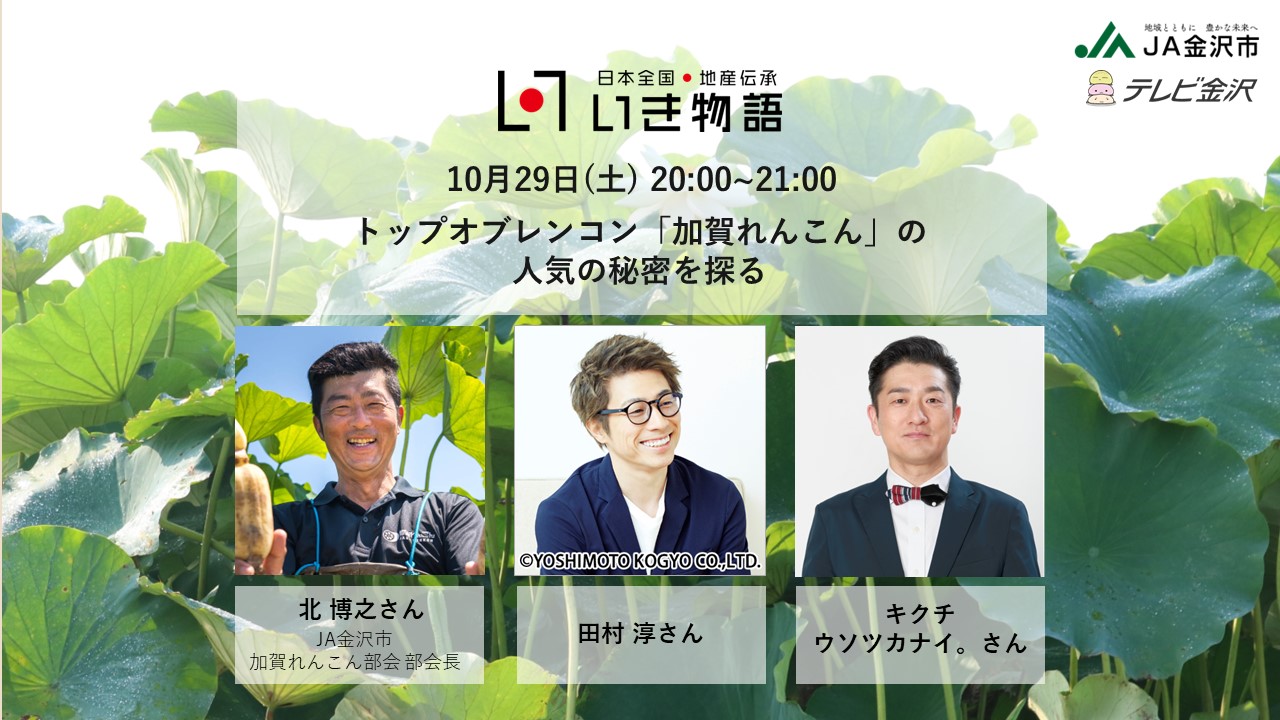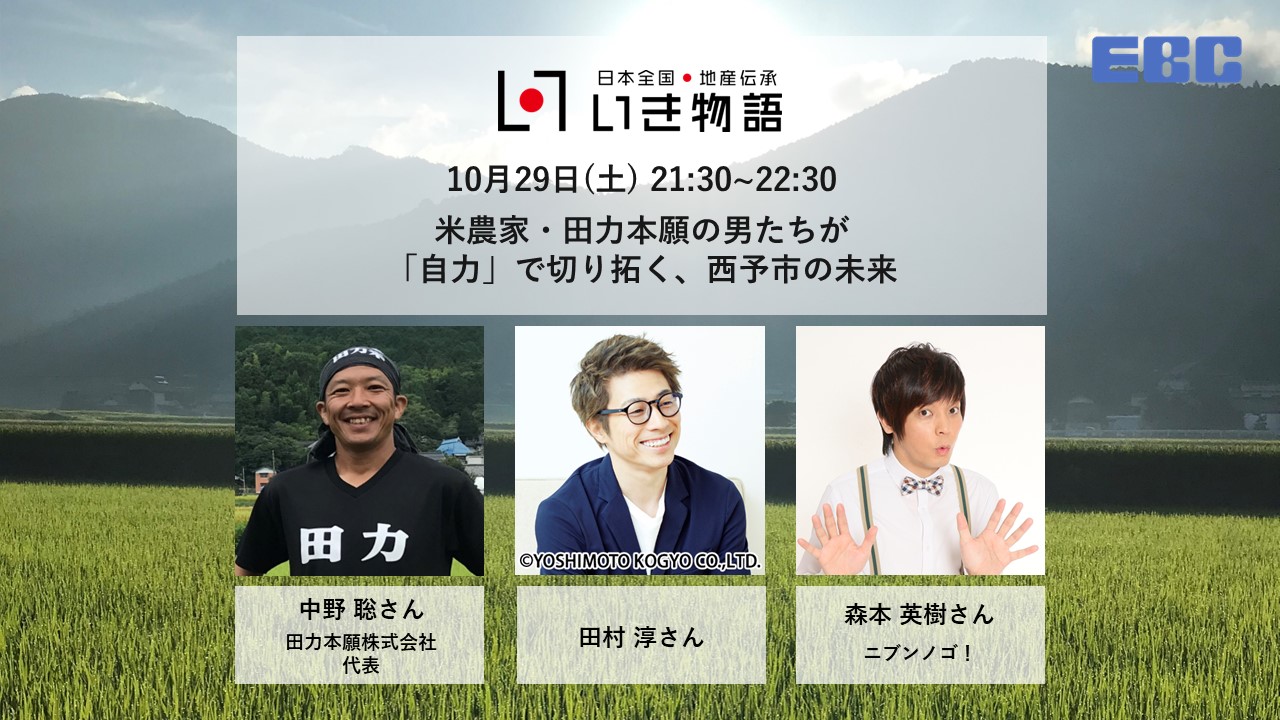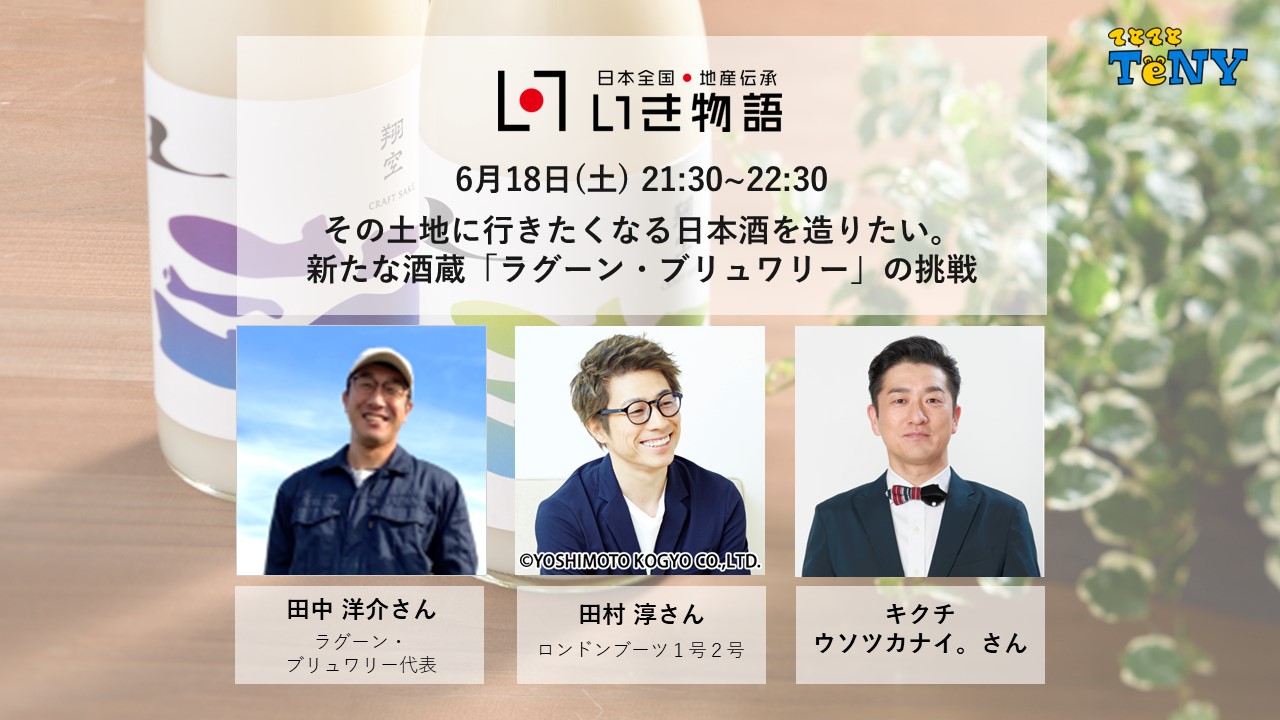A Close Look at the Origins of the Craftsmanship at Somés Saddle, Japan’s Only Horse Tack Manufacturer.
.jpg?locale=en)
Many foods and traditional crafts created with extraordinary enthusiasm and commitment exist in the rural areas of Japan. These products are, of course, of the highest quality, but behind them is also the conviction of the manufacturers and the stories that have resulted in their present state.
Ikimonogatari: All Japan Local Productions and Folklore events will introduce traditional crafts and specialty products that can only be found in local regions and convey the charms of those rural areas by sending broadcasters directly to the source to dig deep into the activities of the people there.
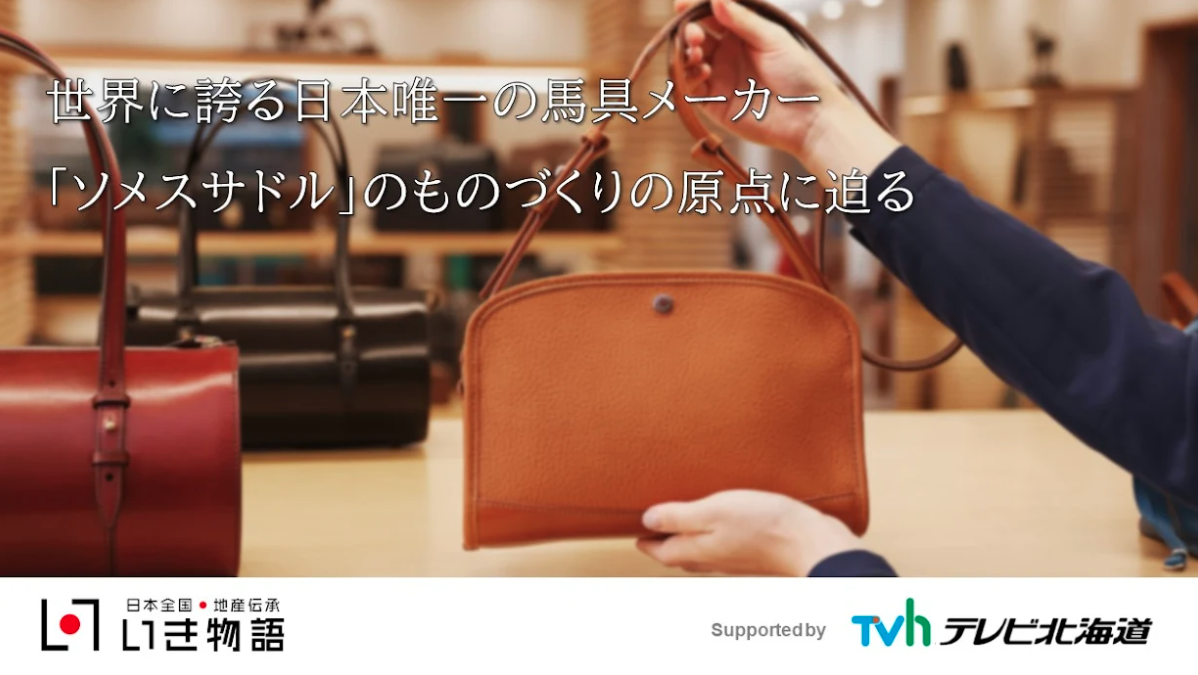
The featured guest for this event: representative director of Somés Saddle, Mr. Noboru Someya
Founded in 1964 in Hokkaido, Somés Saddle is the only horse tack manufacturer in Japan.
The company has been producing horse tack since the pioneer era of Hokkaido, and they still use artisans' techniques that have been passed down through the years to produce their high-quality leather goods.
During this event, representative director of Somés Saddle Noboru Someya joined us to talk about his pride as a horse tack manufacturer, the thoughts and feelings that are poured into the company's leather products, and more.
Special guests: Atsushi Tamura of comedy duo London Boots Ichi-go Ni-go, Hideki Morimoto of comedy trio Nibunnogo, and announcer Ayami Isoda of Television Hokkaido.
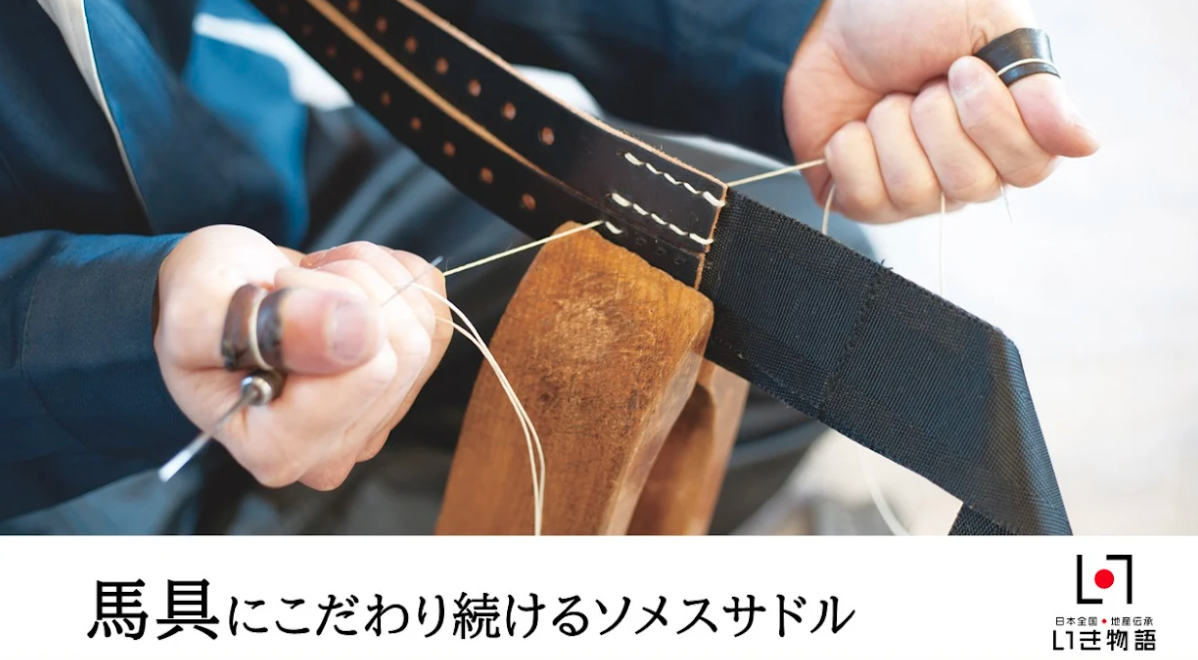
The History of Somés Saddle
Someya: This company was established in the neighboring town of Utashinai City in 1964, 58 years ago, under the name Orient Leather Co. I myself was born and raised in Utashinai. During my childhood, the city prospered from coal mining. However, I think it was in the 1960s when the Sumitomo Group and Mitsui Group coal mines started closing down and the people started moving away, resulting in a population decline.
During that period, Hokkaido was dotted with many harness makers involved in using horses to transport goods, and they were essential to the development of Hokkaido. However, at the same time, they were forced out by mechanization.
There was also a desire to rebuild Utashinai within the city, so they had harness makers from all over Hokkaido gather in Utashinai City, and the company was founded with grand plans to provide technical training to retired coal miners and produce horse tack to export to the United States.
Someya: I am told that the project went well for a while, but it was affected badly by the oil crisis of 1973 and they lost competitive power. As a result, the company was unable to operate.
I am the third generation from the reconstructors, but my father was selected for and accepted the position of company president, creating a direct affiliation with the company. He then started to explore different methods to expand and develop the domestic market.
Coincidentally, I was a university student in Tokyo at that time. I heard about it from my family and thought... wait. I was just starting to think about where to apply for jobs, and I had the simple thought that, for the domestic market, Tokyo would be an important base. I love Utashinai City, where I was born and raised, and I really wanted to do something useful for my hometown. With those thoughts, I jumped into this world and made my own start alone in Tokyo.
Tamura: You mentioned that harness makers from all over Hokkaido assisted each other, but unfortunately the company went out of business. Those people had marketable skills, though, so were they able to utilize them elsewhere?
Someya: Some of them, yes, but many of them have worked in Utashinai City for a long time after having formed a connection. I wasn't involved yet at that time so I can only explain fragments of it, but that's how I heard it.
Tamura: And from there, the director went to Tokyo, after which the company was started.
Someya: The company, of course, continued on in the same way. But, even though I went around from place to place in the world of horse tack, like racecourses and horse riding clubs, sightseeing farms, etc., I was pretty clueless.
Horses that can't be ridden aren't supposed to become things. But, well, when I think about it now, I was just letting my feelings take priority. Because I was able to start from such a place, there are a lot of good examples of general leather products in Europe, so I've always had the desire to try to make general leather goods using the techniques for making horse tack.
●From Orient Leather Co. to Somés Saddle
Someya: In 1985, some OEMs made a variety of merchandise, but I do think that a brand name is very important. Branding as proof of production was a prerequisite, but we changed the company name in 1989.
"Somés" comes from the French word "sommet," which means "summit," which we then paired with the English word "saddle." It's a phrase we coined from French and English; we decided to call it Somés Saddle, meaning "the best saddle." We launched in 1985 with two brand names, Somés and Somés Saddle. After 30 years of business in Utashinai City, we moved to Sunagawa City in 1995 and set up a facility that combined a showroom and manufacturing division. That's how we have arrived at where we are today.
Morimoto: And in the process, your horse tack gradually began to be recognized globally, correct?
Someya: It was a big hurdle to get to that point. I often went to JRA and racecourses, but it took close to 10 years before I was actually able to do any business dealings. It was quite a hurdle.
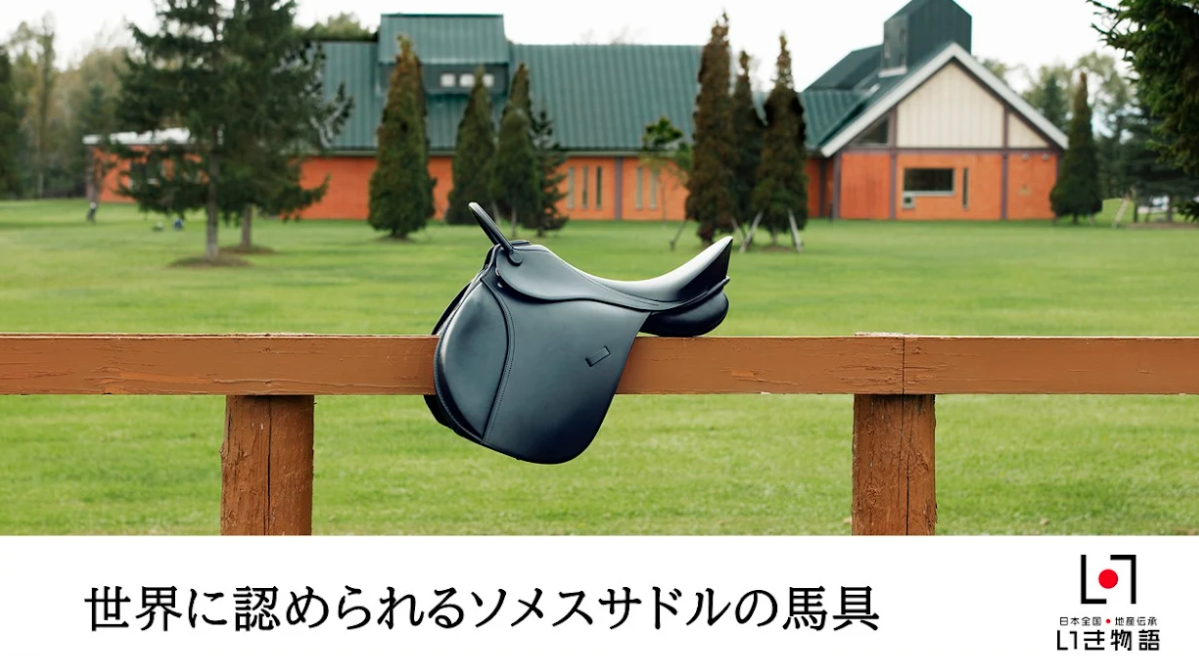
The Imperial Household Agency is supplied with horse tack too, and Somés Saddle products were used in the Ceremony of Accession for both the Heisei Emperor and Reiwa Emperor. Also, the championship winner of the 2021 Prix de l'Arc de Triomphe was a German rider who used Somés Saddle horse tack, and that rider said that the horse tack he used was perfect.
Morimoto: Taking the world with horse tack. I'm curious, what does the horse tack need in order to win a championship?
Tamura: The rider said it was perfect, so that probably means that the saddle sits on top of the horse. It doesn't slip and create space between them, it fits perfectly and holds the rider in place as if there isn't a saddle at all. That's what I'm imagining, at least, but what did they actually mean?
Someya: People who ride horses use saddles, but they need to have a sense of unity with the horse. I can't ride horses at all, but I do believe this is how he thought of it.
Tamura: Even if you talk about fitting the saddle to the horse, they're living creatures, and it's not as if they understand human languages, so we can't ask the horses what they want us to do. It seems like figuring that out would take a really long time.
Isoda: About how much does horse tack weigh?
Someya: In regards to racing saddles, the most commonly used ones are about 550 grams.
The weight varies depending on the rider and the race, but the premise is the rider's body weight plus the weight of the saddle, so we have to try to make the saddles as light as possible.
Morimoto: I'd like to know if you're working out that you can't coordinate with the horses. Horses can't talk, right? What do you do to make a good fit?
Someya: Racing saddles and riding saddles can both be used on the same horse, but horseback riding, equestrianism, is an Olympic event. It's very profound, and the necessary tools require a high degree of processing and technical capabilities. In Europe, simply being an artisan who makes saddles is highly regarded. I have been to Europe many times, and when I went I brought a catalogue with me and visited a number of places. Often when I showed people the catalogue, their behavior would change.
Morimoto: Do you check the fit by actually putting it on a horse?
Someya: Yes, that's right. There's no point to it if you don't put it on the horse.
Morimoto: Do you mean like seeing a gap or something like that?
Someya: Yes, the horse's back is curved. There is a bone called the withers that sticks out of the shoulder. This is a really important place. In addition to properly protecting it, we have to make saddles that the riders can use easily. These are the main principles.
Tamura: It's for both of them, isn't it. The saddle has to fit both the horse and the rider so that they are connected. In that sense, if one or the other is lacking, it isn't a good piece of horse tack.
Someya: Yes, that's right. There's no mistake that they are very delicate tools.
Morimoto: Somés Saddle is a product of craftsmanship.
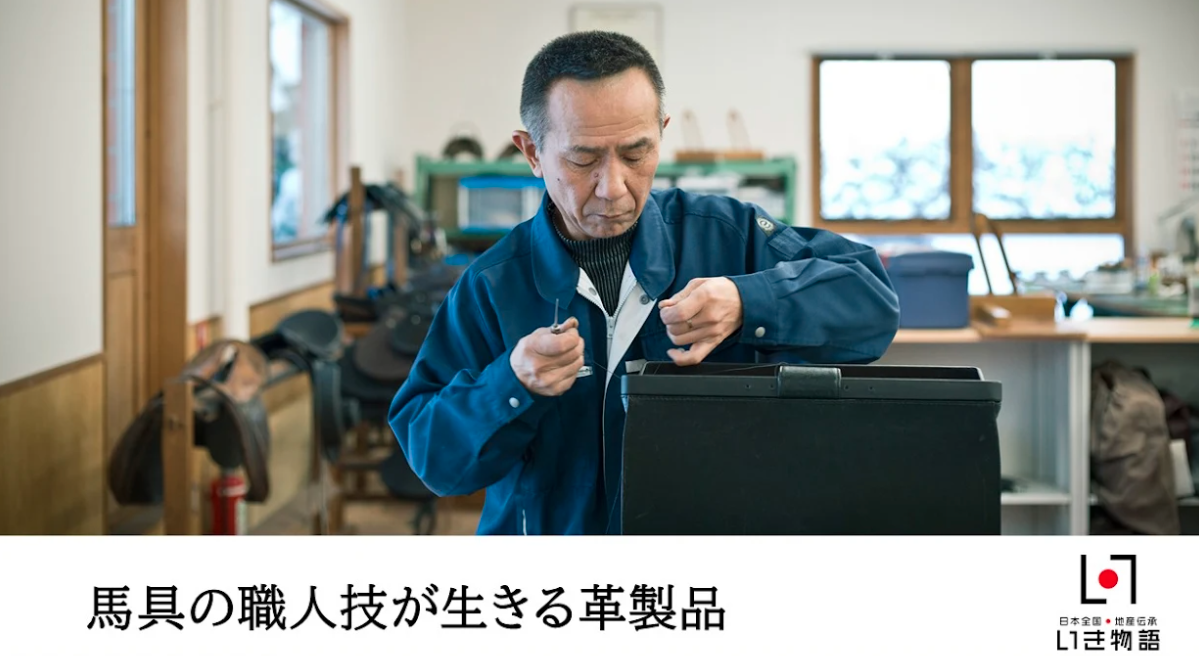
Morimoto: I think a wallet has been sent to you Mr. Atsushi. What do you think?
Tamura: The feel of it is excellent.
Someya: This is actually horsehide. It's leather from the rump and buttocks of a horse.
Someya: Cordovan uses a special technique. In regards to this cordovan, the part on the back is processed to become the front side of the leather.
Morimoto: Is that not done normally?
Someya: Normally the front side is used. A horse's rump carries an extremely high rate of momentum, so the fiber density is very high. When there is a high fiber density, that is proof of high durability. It's sturdy.
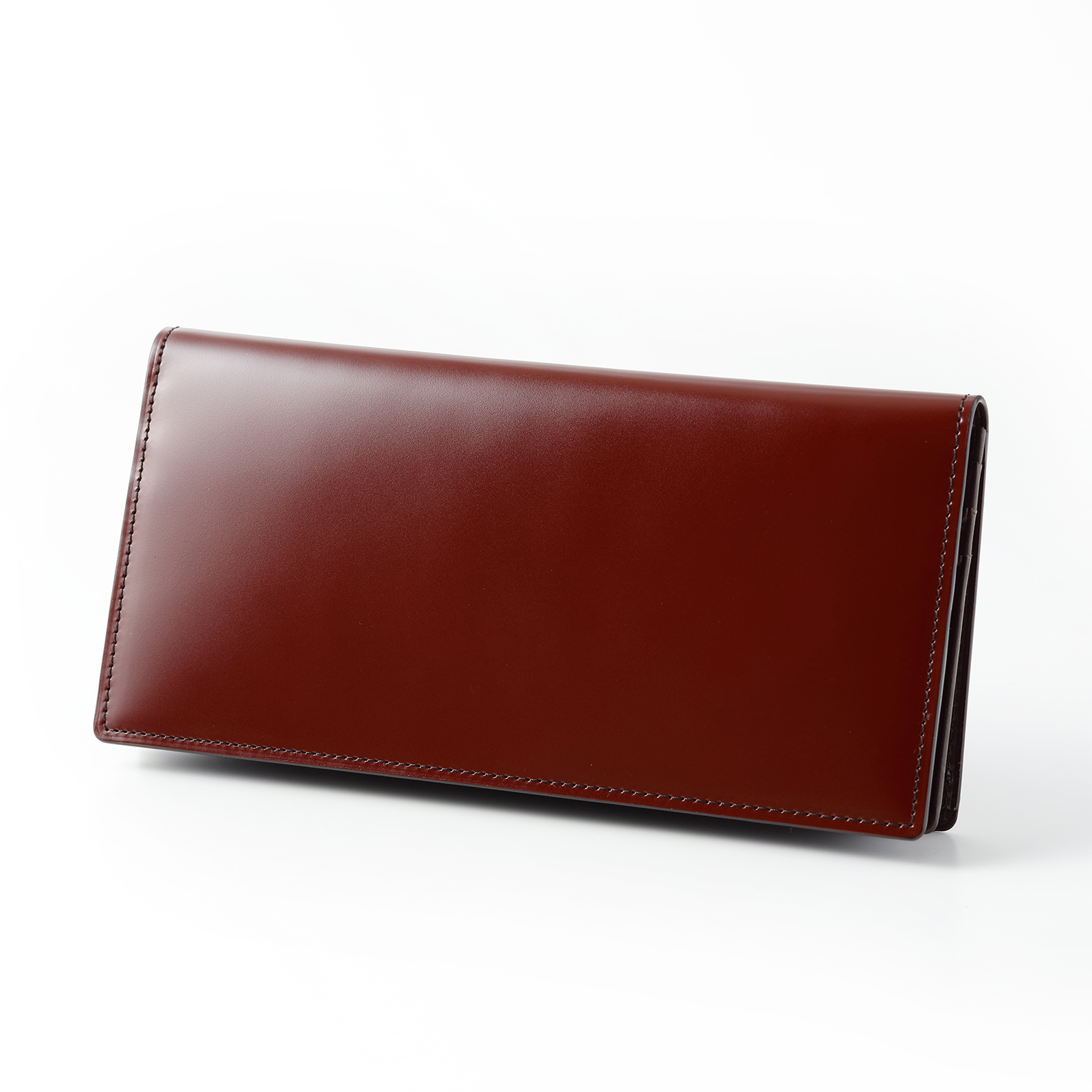
Morimoto: What do you think after actually touching it?
Tamura: I can't tell the difference between the inside and the outside, but either way it's nice to the touch and it makes me want to keep rubbing it. Really, it's like my fingertips have never experienced this sensation before, this density, I guess... I can't express it well in words, but I want to keep touching it.
Morimoto: Is it smooth? It's not rough?
Tamura: It's not rough. Even though it's a very elegant hue, it's soft to the touch.
And, like the director said a moment ago, a saddle has to fit perfectly to properly connect a horse and rider. Even just by touching this wallet, I can tell that the gentle processing techniques have come together so that, if this leather is at the place of contact between the rider and the horse, it won't be a burden for either of them.
Until now, my image of leather was that it was stuff, but this wallet is soft, somehow. So much that it's laughable.
Morimoto: The horse tack artisans also make general leather products in the same way, correct?
Someya: Yes, with that kind of "ism" they are developing and making products on a daily basis with their horse tack technology.
Morimoto: That's why Mr. Atsushi feels comfortable with it when he picks it up. The artisans make their products so that the people who use them can understand them.
Someya: That's a wonderful compliment.
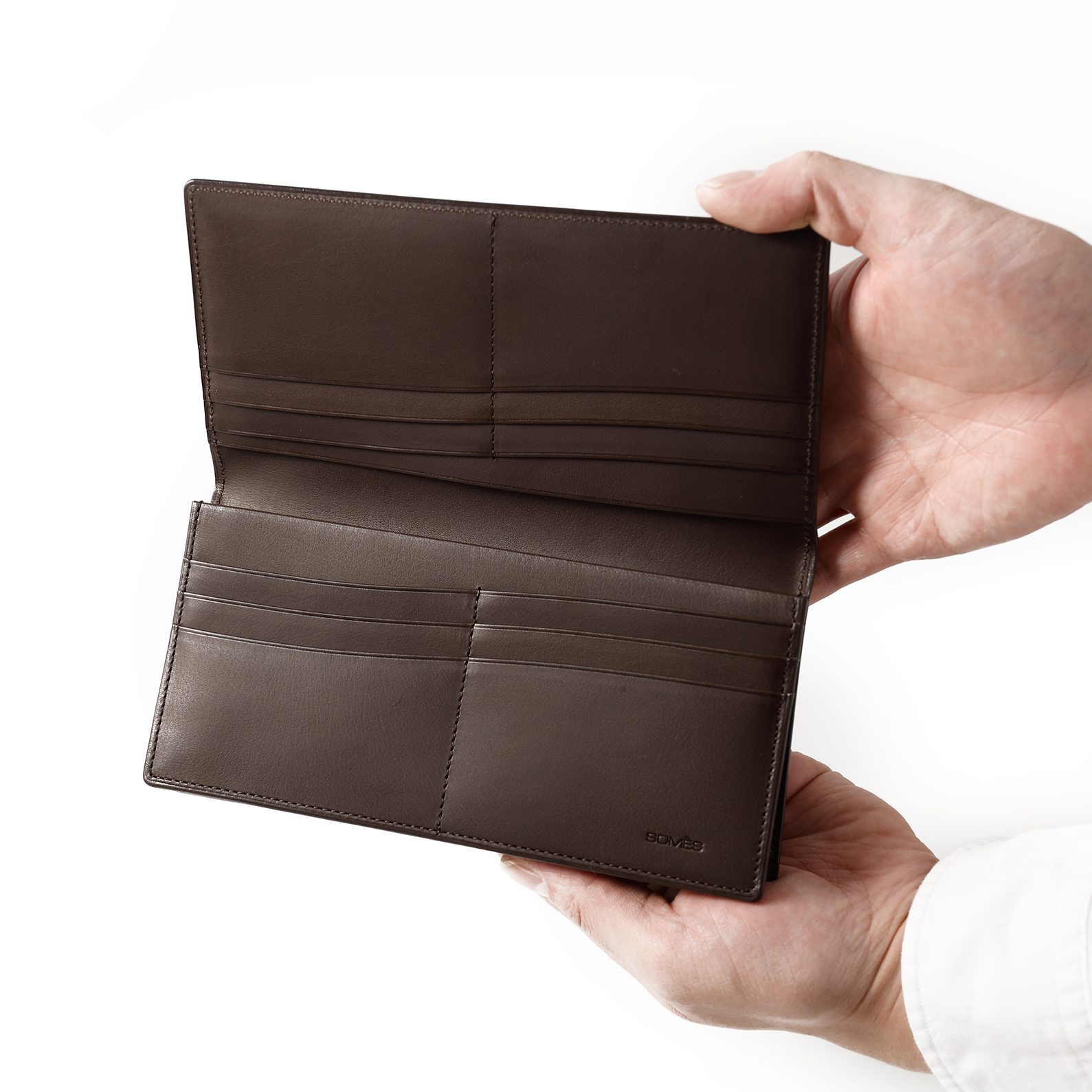
Someya: The specifications for the inside are yet another kind of leather called baby buffalo. It's the hide of a water buffalo less than six months old.
Water buffalo are known for their powerful pulling force. Taking advantage of this characteristic, the leather stretches relatively easily when you put in or take out cards. So, it's not that the leather doesn't stretch as much as possible, but we use baby buffalo to try to prevent that from happening where it does stretch as much as possible.
Tamura: The water buffalo part is soft, too. The leather that I'm familiar with is much stiffer. Leather gets softer with use, right? But this leather already has a softness like it's been used. So it feels good in your hands. Or, how should I say it, I just got this wallet today, but it feels familiar as if I've had it for a long time.
That's really curious. Maybe it's the processing techniques. Director?
Someya: There isn't anything more to add to what you've said.
Tamura: I really want everyone to touch this. If you did, you'd understand what I mean when I say that it's gentle.
Morimoto: Mr. Atsushi, you always say what you mean frankly, don't you. That's the kind of person you are.
Tamura: I do. (If I can't tell the difference) I'll say that I don't get it, but there is a stark difference here. Or maybe this is how leather products should be.
Morimoto: You've been smiling for a while now.
Tamura: I'm happy that I have the opportunity to experience this kind of skill.
Attention to Detail Hidden in the Design of Card Holders
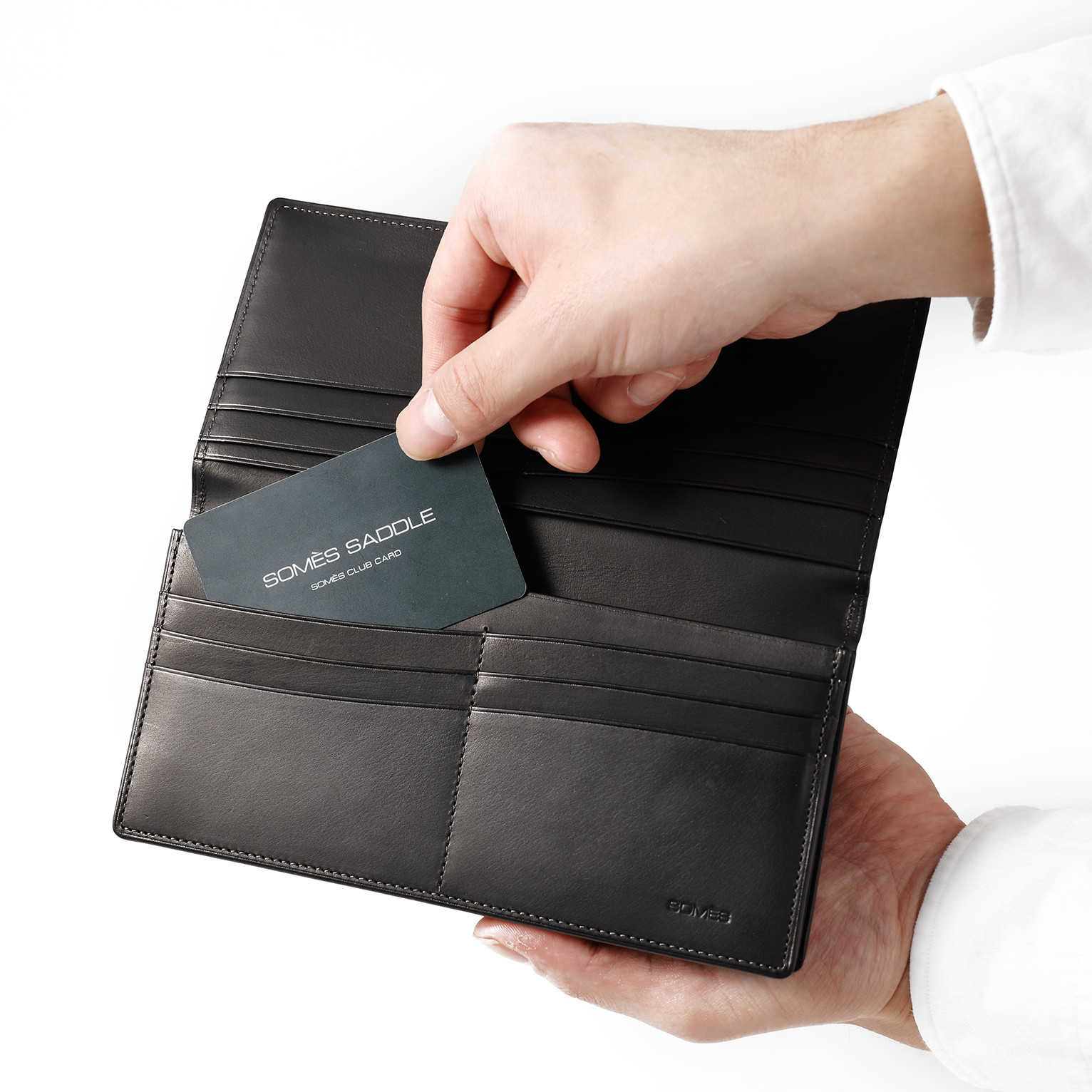
Tamura: I think it's the design, but it's made to be slightly wavy so that it's easy to take cards out. This was probably researched, wasn't it?
Someya: Of course we wanted it to be user-friendly, but we actually made the wavy part in the image of the R-curve of a saddle.
Morimoto: You really don't forget about the horse tack. It's incorporated in every aspect.
Tamura: You see a lot that are straight, so I wondered why it was wavy; that's the reason behind it.
Morimoto: It's because it came from horse tack. It has taken a bit of work to get that line.
●The Maintenance of Leather Products
Someya: Leather is very sturdy, but after using it for a long time, parts of it might weaken, the threads might break. It might be a considerably long way off, though. Leather ages over the years, but that's ok.
Tamura: It already feels good in my hands, but how will it change if I continue to use it?
Someya: The color will deepen a little, and it will become a little more flexible. Only a bit, but it will change. If a thread breaks, we can perform maintenance on it and sew the thread back on.
Morimoto: Mr. Atsushi, there are some leather products that need to be, for example, oiled. What do you think about that kind of care? Have you ever used those kinds of leather products?
Tamura: I'm actually the type of person who likes to take good care of my things, so I do use them.
Morimoto: So, even if you get a wallet like this?
Tamura: I've never had a wallet that I had to take care of, so this is a first for me.
Morimoto: Director, what kind of upkeep does it need?
Someya: For the time being, there isn't much you need to do. If you think the surface of the leather has dried out or such. It is natural for that to happen, after all, since some parts of skin do breathe. If you give it a little care when you notice something like that, such as applying some oil, you can expect it to age well.
Tamura: Would horse oil be appropriate for that?
Someya: There are some specialty oils, but I think regular oils will work just fine.
Morimoto: It's a bit shiny.
Someya: The shine does change, but it won't always be shiny. The term "familiarize" is abstract, but there's no mistake that it will develop more character. I have used the same one for a long time, almost ten years.
Tamura: I do something called kintsugi, which is restoring broken dishes with lacquer. The dishes can't be restored just by applying lacquer over and over again, so the grain of the lacquer is refined and polished, and then it is wrapped in gold. It has the brilliance and elegance as if it had been coated in lacquer. I guess there is something that gives it this brilliance. Something secret.
It has such an amazing elegance that I wondered if it had been finished in lacquer. But if it had been finished in lacquer, it would be very stiff. The fact that leather processing techniques can do this much makes me feel like I'm touching something really good, which is exciting.
Attention to Detail in Somés Saddle’s Belts
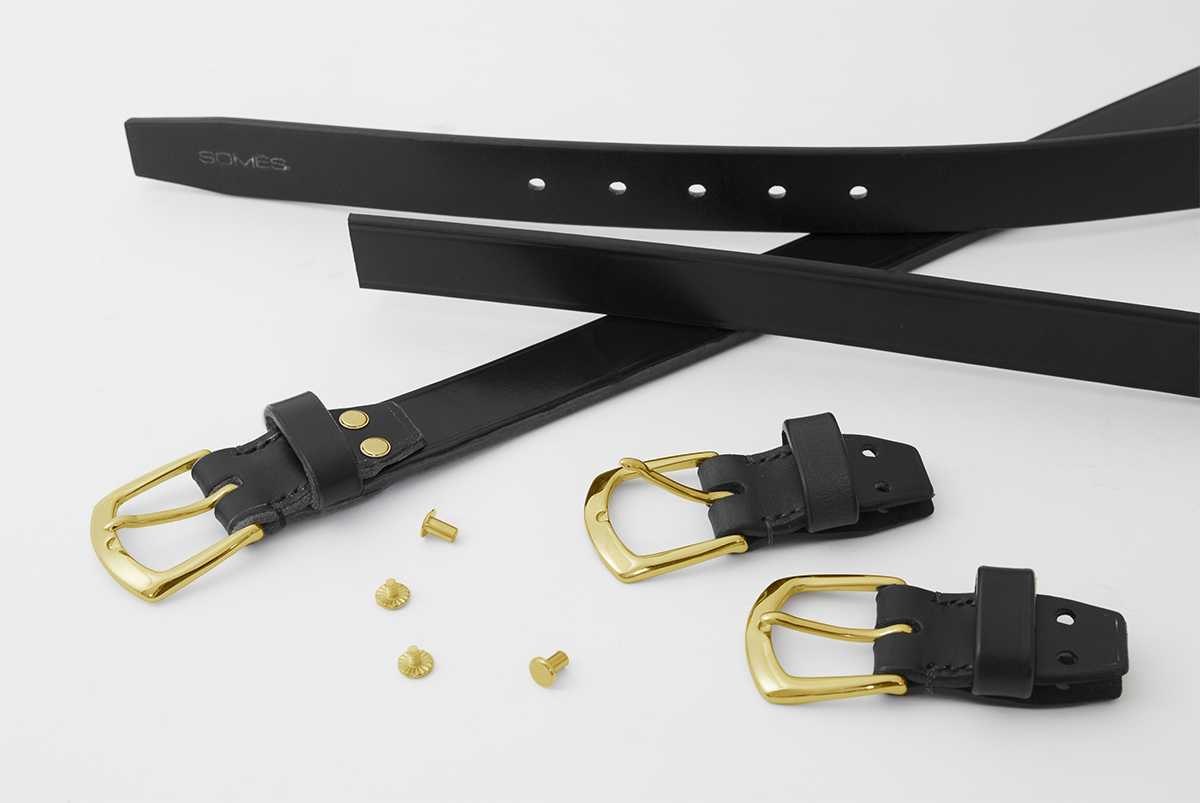
The various techniques of Somés Saddle are also utilized in its accessories. There are a number of leather products that can be used in daily life.
Someya: Needless to say, our belts are made of harness leather, the same leather that is used to make the horse tack that is worn by horses on a daily basis. It is about 5 millimeters thick. Normally, 5-millimeter leather is difficult to obtain.
Our belts can be worn by men or women. After wearing a belt for a certain amount of time, the back of it will start to bend. That's when it will start to feel familiar. Soft leather would start to fall apart, but this leather can be used forever as long as your waist size doesn't change. The back will bend to an arch shape and stop there.
Morimoto: So that is also something you pay attention to with horse tack.
Someya: Yes, the leather we usually use is the same as that in the middle of a saddle.
Morimoto: [Holding up a belt that has actually been used.] Ones that have already been used are much softer. The shape of it bends, but it's like it's to fit my body.
Someya: Once you use these, you're not going to want to use any other.
Tamura: I see, so it ends up being something that fits your own body.
Morimoto: Yes, and I'm getting more and more attached to it. I would like a leather belt of my own.
Isoda: There are already a number of different general leather products, but does Somés Saddle intend to expand further in the future?
Someya: Leather has a wide range, but it isn't limited to the world of bags and luggage; it also includes interior design. This particular field is what we're good at, which is why we've been making products of this genre, but we would also like to develop more interior-oriented products.
Morimoto: Mr. Atsushi, is there anything you want or that you wish you could have?
Tamura: The feel of this wallet is so amazing.... But, you only take out your wallet when you're paying for something. I want to be touching it all the time, though, this Somés technology.
So, I can always be touching something small for a smartphone. A phone case, for example.
Someya: We have the technology to make that. We haven't manufactured that as a product yet, though.
Tamura: It really pains me that I have to get a new case when I change the model of my phone. I hope it will be something I can keep in my hands no matter what model comes out.
Even if it's something I attach to my phone case afterwards, I want to be touching the leather, or should I say I want to have this sense of familiarity with the leather, be closer to it.
If we can bring leather products to the point where it's a given that they're always nearby, for other kinds of products as well, I think more people will start to buy them.
Someya: Leather is a natural material, but also, I have been working with it for nearly 45 years, at the same time it has the mysterious power to enrich people's feelings. I have that feeling myself sometimes. It's a real feeling.
.jpg?locale=ja)
A Message from the Guests
Noboru Someya, representative director of Somés Saddle
We started out in the horse tack business, and we still continue making horse tack today. In addition, we have also created many leather products derived from that. We will continue to work together with our employees towards the same goal. We will continue to take pride in being a horse tack manufacturer, which is something we must always keep hold of. Our wish is to become a company that is recognized as a first-class organization by our customers and business partners.
Atsushi Tamura of comedy duo London Boots Ichi-go Ni-go
I feel like my concept of leather products has been overturned. That's the interesting thing about leather: when you touch a first-rate product, you finally understand what leather processing techniques actually mean.
I'm sure I'll come across many other leather products in the future, but this Somés Saddle wallet has definitely become my new standard. I'd put my focus on whether I am able to show the softness of this wallet, and whether I have any interest in it. That's how much I enjoyed learning about leather products today, and I'm looking forward to life with leather in the future, too.
Morimoto: Craftsmanship is amazing, isn't it? It moves people's hearts.
Sponsored Links
Unmissable Tours
Expand your horizons by interacting with diversity. Take a look at guided tours on which you can connect personally with the guides and have truly extraordinary experiences.
Search
